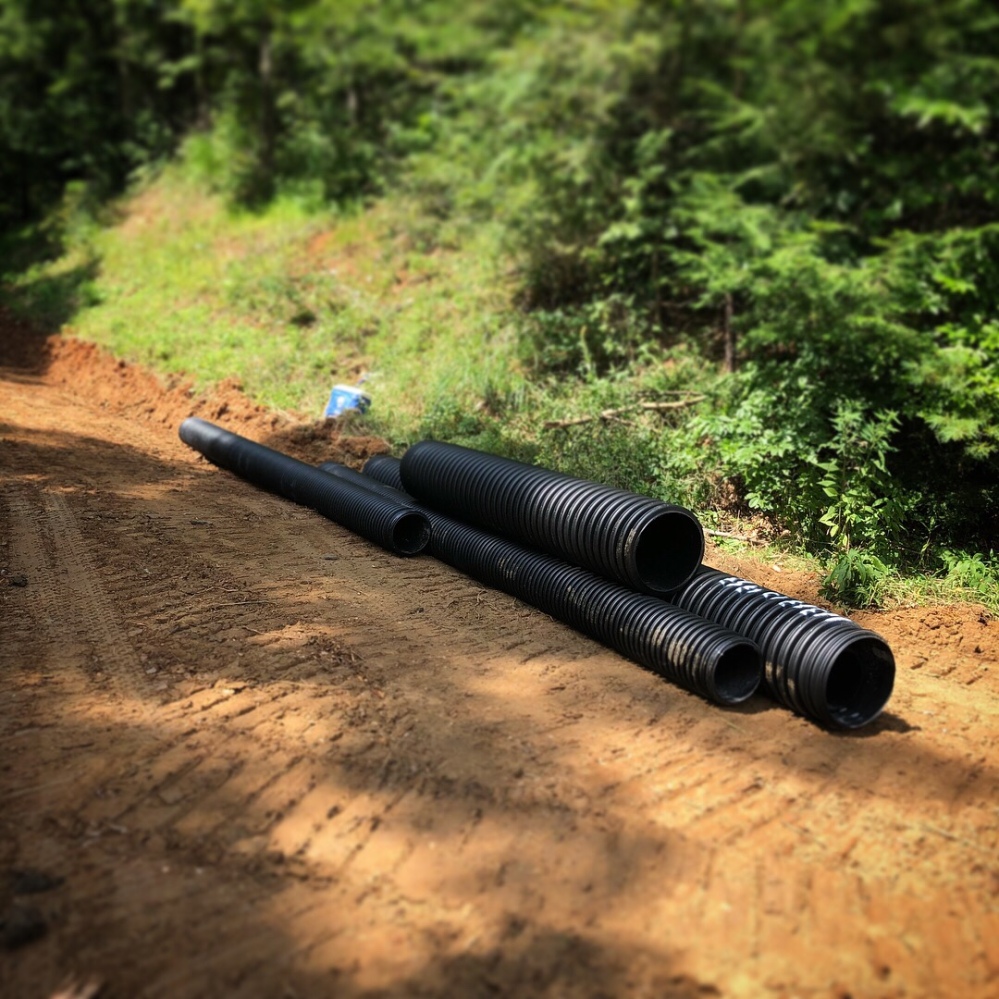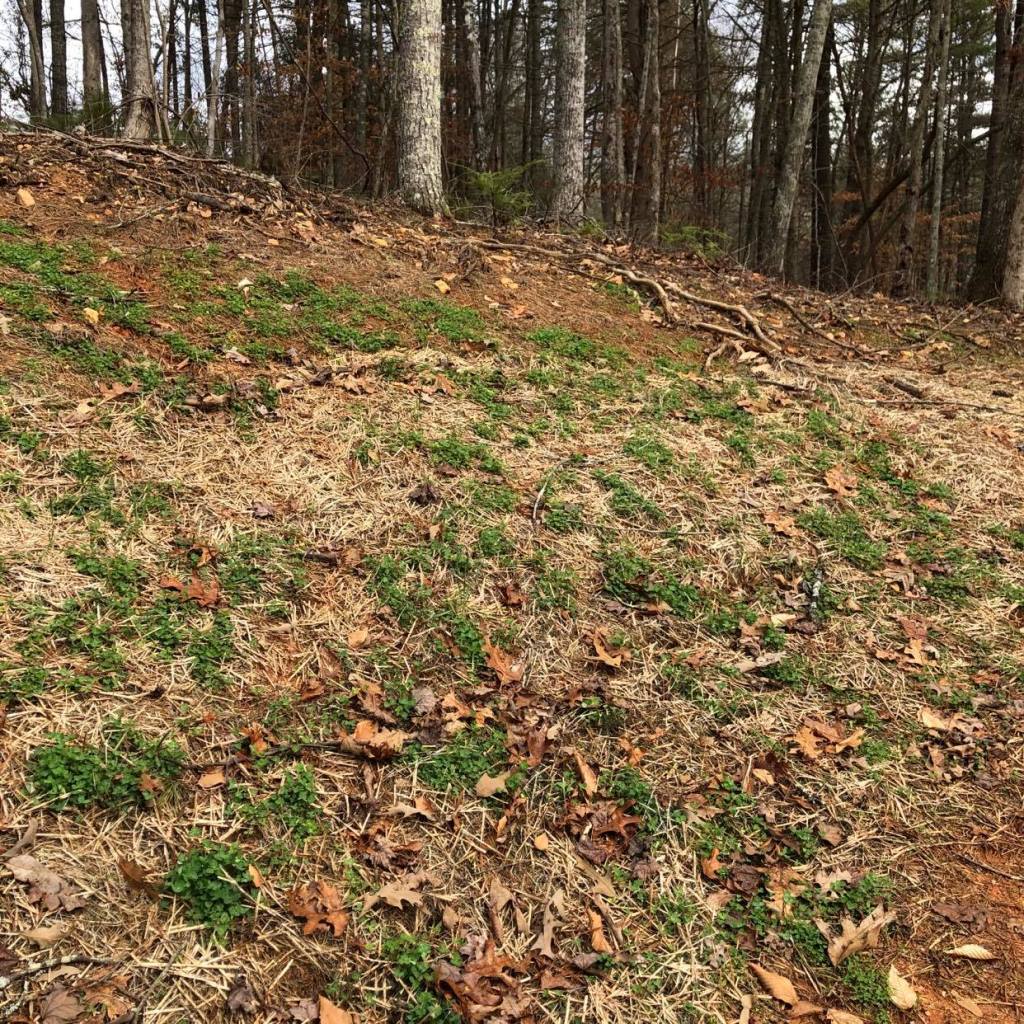It was late summer of 2019, and it had been months since I’d made the 2.5 hour drive from my parents’ house, where I’d been living, to Joyous Gard. My work schedule had complicated things, and — frankly — I was at a loss as to how to prioritize the mountain of work I needed to do to make my raw, wild land habitable. There were piles of logs still awaiting milling. Enormous brush piles I needed to chip or burn. An intimidating tangle of overgrown weeds that needed beating back. But weighing most heavily on my mind were the bare banks surrounding my homesite and bordering my new driveway…
What I was met with wasn’t pretty.
As I drove up the road Sam excavated for me the previous fall, I noticed a trench forming along one side where rushing water had cut down through the gravel and was creating its own path to the tiny rill feeding the river branch across the road from me. The drain pipe was clogged with red clay and debris. But it was the road bank that made my stomach clench.
Deep channels wore through what had been a smooth bank face, and the red clay had washed over the road stone, nearly obscuring it in spots. I made the switchback from the road to climb the driveway and saw similar channels on the home site bank, along with a small furrow running the length of the bank and into the woods. Clearly, hard rains had been funneling water down through the trees, taking mud and clay with them and sending it all down to contribute to the road’s thick coating of sludge. My heart sank.
I’d procrastinated on seeding the banks, and now I had an erosion problem to deal with.
a brief rewind, for context
In the two years immediately preceding and since I purchased the land I call Joyous Gard, I’d struggled with numerous financial and emotional setbacks. I’d set out on my adventure, naively believing the plans I’d mapped would unfold neatly over the course of a few months, and I’d be living a simple life in a yurt in the mountains before the summer of 2018. I soon discovered that the road to progress is a messy one and no amount of obstinacy or impatience would make the weather, contractor schedules, finances, or pretty much anything else adhere to my timeline.
Overwhelmed with frustration, I didn’t just surrender to the ebbs and flows of these challenges; I nearly drowned in them.
advice from an unexpected source
About the time I despaired of making any progress whatsoever, I found a contractor who was willing to meet with me to estimate the cost of a yurt deck. He was the reason for my drive to the mountains that day, and when we were done looking over the deck plans and talking about yurt placement, he shot me a side-eyed glance and commented about the state of the bank arcing across the back of the clearing.
“You’re going to have to do something about that erosion, you know. Your road is a mess, and you’re going to have to re-dig your drainage.”
I deflated a little, feeling some of the happy energy of our meeting drain out of my body. “I know,” I told him. “I just have no idea how to go about it. Seeding it seems like a waste of time, since even the wild plants don’t seem able to grow on it.”
He cocked his head, squinting a little at the bank surrounding the yurt site before offering the advice that got things moving (or, more accurately, got them to stop moving):
- Buy some seed and coat the soil surface with it, knowing some would run off.
- Get a couple of bales of hay, not straw, and throw it over top of the seed, knowing it would also contain seed and would potentially sprout, thereby adding value.
- Buy some rock and lay it in the path of the run-off to slow the water’s progress and encourage it to soak into the soil along the way to the road bank so it would dump less clay onto the road.
His suggestions were inexpensive and less labor-intensive than the visions running around in my head. I thanked him, relief blooming in my gut, and he drove off leaving me with a glimmer of hope.
When I shared the plan with a neighbor, he further suggested getting straw mat to hold all of it in place, which turned out to be a key component to the success of my efforts.
the value of good neighbors
And about my neighbor, Arthur. Not only did he offer good advice, but he also offered to give me some bales of old hay that was no longer suitable as feed and to help me execute on the plan. I accepted the hay but refused the offer of help. I didn’t want to impose on him, figuring I’d be able to manage myself, even if it took longer than I’d like.
“Ok,” he drawled slowly, squinting at me dubiously. “But if you change your mind, you just let me know.”
A week or so later, Arthur delivered the hay bales and even unloaded them for me.
onward, through sweat and muscle
Working through the heat and humidity of the remaining summer weekends, I managed a reasonable facsimile of what the carpenter suggested. Rolling the straw mat out over the hay and seed turned out to be hot, sticky, difficult work on the bank around the home site.
I was, however, intimidated by the high, steep bank running along the tractor road and up my driveway — which resulted in still more procrastination as I avoided finishing the task. When I finally steeled myself it was in late January 2020, after a long, wet fall and winter, and rolling out the straw mat was every bit as difficult as I imagined it would be. Moreover, working alone made me feel uneasy. As I grew tired, I started making dangerous missteps.
In fact, I nearly broke my leg when I lost my balance as I tried to maneuver one of the long, awkward rolls of matting along the top edge of the bank. I slid partway down, lodging my foot under a fallen tree and nearly snapping my femur as I fell forward with the weight of the roll.
That was when I decided to take Arthur up on his offer of help. Our only tools were my planning and ingenuity, Arthur’s strength and agility, and the laws of gravity, but we got the job done quickly and efficiently. The seed sprouted and grew, putting down roots that held most of the soil and giving the previously reluctant native plants a more secure place to put down roots of their own.
surprising results
Fast-forward a little to late February 2020. Arthur stands at the bottom of the bank, looking up in bafflement at his work from just a couple of weeks ago. The grass was already sprouting.
“I’m surprised,” he said with his usual verbal economy.
“Me, too,” I admitted with a sidelong glance at him. He chuckled and shook his head in amazement.
A few days later, he drove up the tractor road to tell me he’d expressed his surprise to a member of his church, who’d asked him when, precisely, we’d planted the grass. Arthur replied that it had been early in February. “Ah,” his friend had said, “right before the full moon, then.” Arthur and I hadn’t known it, but apparently planting grass (and, presumably, other ground covers) around February’s full moon (which had been on the 9th that year) was perfect timing.
Arthur expressed confusion about this, but I just shrugged and told him, “The moon controls tides, the pushing and pulling of water, right? Kinda makes sense to me that it would pull seedlings from their shells.” He chuckled softly, saying only, “Well, I guess it does.”
As far as I was concerned, this small movement forward — and the generosity of my neighbor — mattered more than any possible explanation.








And I bet your neighbor feels good for doing good.
LikeLiked by 1 person
True! I’m sure it fed his generous heart. Another win.
LikeLike